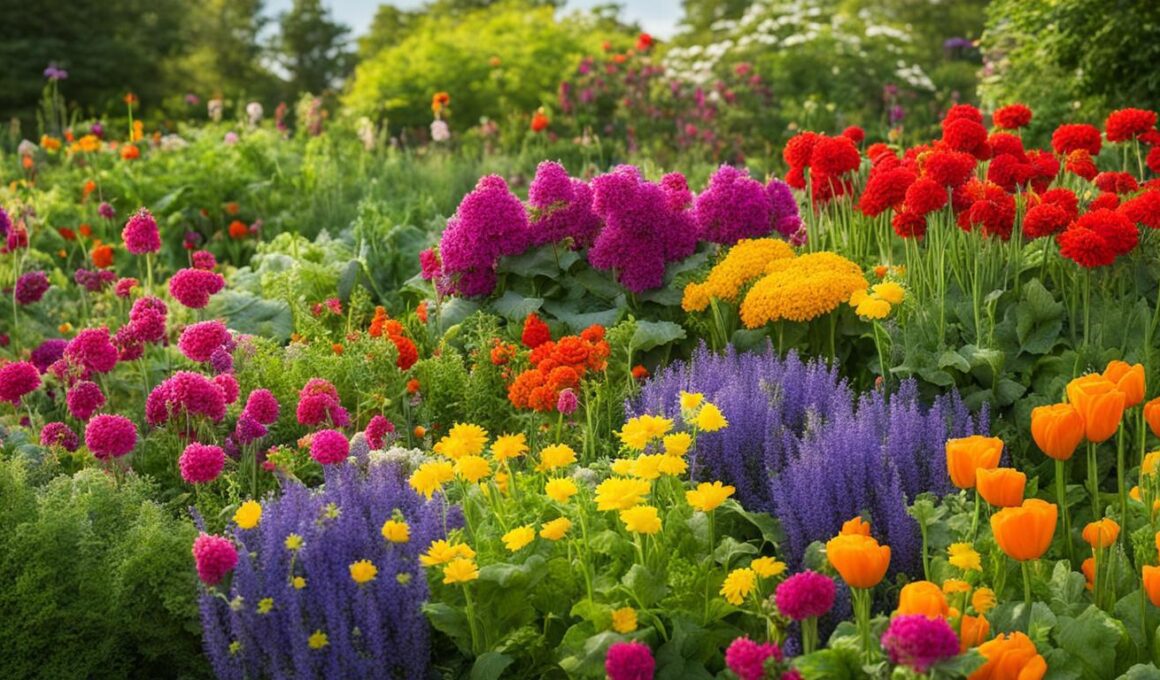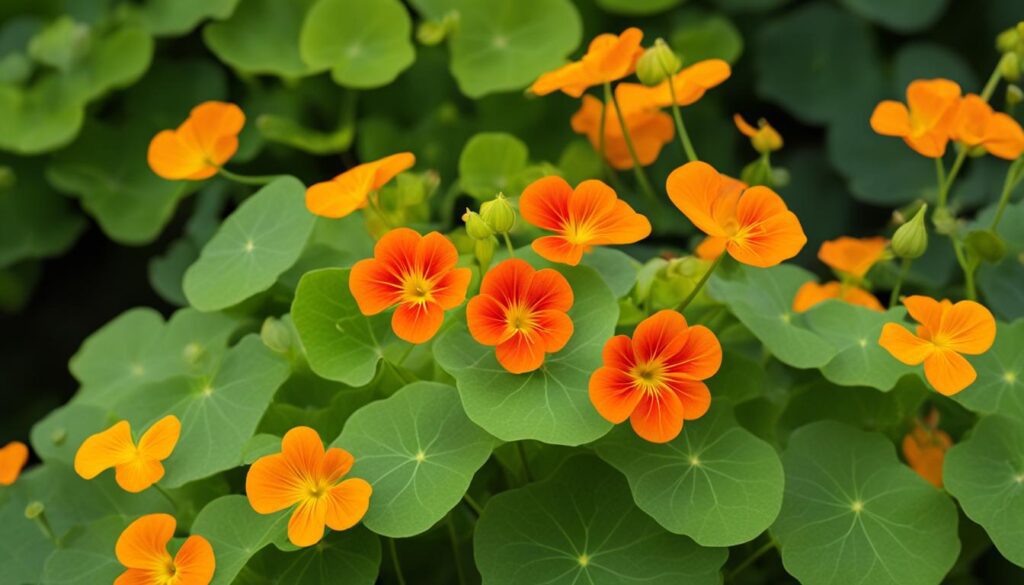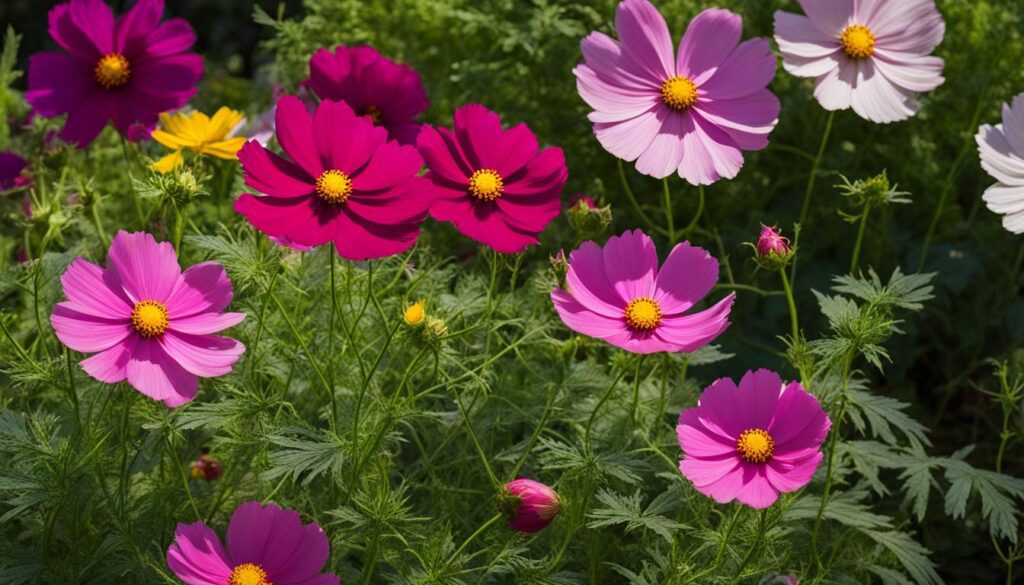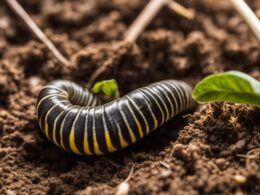Flowers are not only beautiful but also offer numerous benefits when grown alongside vegetables in your garden. They can attract beneficial insects, deter pests, improve soil quality, and enhance the overall appearance of your garden. In this article, we will explore the best flowers to grow with vegetables, based on research and expert recommendations.
Key Takeaways:
- By growing flowers with vegetables, you can create a lush and vibrant garden.
- Flowers attract beneficial insects and deter pests, promoting a healthier ecosystem.
- Choose flowers like borage, nasturtiums, pot marigolds, cosmos, and lavender as companions for your vegetable plants.
- These flowers provide various benefits such as enhancing pollination, repelling pests, and improving soil quality.
- Consider the specific needs of your vegetables when selecting companion flowers for optimal results.
The Benefits of Growing Flowers with Vegetables
Growing flowers alongside vegetables in your garden can offer a multitude of benefits. Not only do flowers add beauty and color to your garden, but they can also play a crucial role in enhancing the overall health and productivity of your vegetable crops. By attracting beneficial insects, repelling pests, and improving soil quality, flowers contribute to creating a harmonious and thriving ecosystem. Let’s explore the various benefits of growing flowers with vegetables:
Attracting Beneficial Insects
One of the major advantages of growing flowers with vegetables is their ability to attract beneficial insects like ladybugs and bees. These insects play a vital role in pollination and can help increase the yield of your vegetable crops. Ladybugs, for example, feed on pests such as aphids and mites, keeping their populations in check and preventing damage to your plants. Bees, on the other hand, are essential for pollinating many vegetables, ensuring the production of fruits and seeds.
Repelling Pests
Certain flowers have natural pest-repellent properties, making them valuable companions for your vegetables. Marigolds and nasturtiums, for instance, emit chemicals that repel pests like squash bugs and cabbage worms. By planting these flowers alongside your vegetables, you can help protect your crops from these destructive pests without resorting to chemical pesticides. It’s a natural and eco-friendly way to maintain the health and productivity of your garden.
Improving Soil Quality
Some flowers, such as lupines, have the unique ability to improve soil quality by increasing nitrogen levels and enhancing drainage. Lupines are nitrogen-fixing plants, which means they have a symbiotic relationship with beneficial bacteria in their roots that convert atmospheric nitrogen into a form that plants can use. By incorporating lupines or other nitrogen-fixing flowers into your vegetable garden, you can enrich the soil and provide your crops with the essential nutrients they need for optimal growth.
These are just a few examples of the numerous benefits that come with growing flowers alongside vegetables in your garden. By creating a diverse and well-balanced ecosystem, you can enjoy not only a beautiful and vibrant garden but also healthier and more productive vegetable crops. So why not harness the power of companion planting and let your flowers and vegetables thrive together?
Borage (Borago officinalis)
Borage, scientifically known as Borago officinalis, is an excellent flower to grow alongside your vegetables in the garden. It offers a multitude of benefits and is a favorite among both gardeners and pollinators. Borage is a fast-growing herb that attracts bees and other pollinators with its beautiful blue flowers.
One of the unique qualities of borage is that both its leaves and flowers are edible. The leaves have a subtle cucumber flavor, making them a refreshing addition to salads and drinks. Borage is also known to have medicinal properties and is often used as a herbal remedy for various ailments.
“Borage is a fast-growing herb that attracts bees and other pollinators with its beautiful blue flowers.”
When it comes to companion planting, borage is a great addition to vegetable gardens, especially those with tomatoes and squash. Borage helps to repel pests like tomato hornworms and cabbage worms and can improve the overall health and productivity of nearby plants. It is also a self-seeding plant, meaning it will come back year after year with little effort on your part.
| Companion Vegetables | Companion Herbs |
|---|---|
| Tomatoes | Basil |
| Squash | Dill |
| Cucumbers | Mint |
As you can see from the table above, borage pairs well with tomatoes, squash, and cucumbers. Its companionship with herbs like basil, dill, and mint can also benefit both the herbs and nearby vegetables. Consider adding borage to your vegetable garden to enjoy its edible and aesthetic qualities, as well as to create a thriving ecosystem.
Nasturtiums (Tropaeolum majus)
Nasturtiums are vibrant and versatile flowers that make a great addition to any vegetable garden. These beautiful blooms not only add a pop of color but also offer a range of benefits to your garden. Nasturtiums are known for their ability to attract pollinators like bees and butterflies, which can improve the overall health and productivity of your plants.
One of the standout characteristics of nasturtiums is their ability to repel pests. These flowers contain natural compounds that deter pests like aphids, squash bugs, and beetles. By planting nasturtiums alongside your vegetables, you can help protect them from these common garden pests without resorting to harsh chemicals.
In addition to their pest-repelling properties, nasturtiums can also be used as a trap crop. They attract aphids, which can be a nuisance to many vegetables, and redirect them away from your main crops. By sacrificing some nasturtiums to the aphids, you can preserve the health and vitality of your vegetables.
| Nasturtium Varieties | Companion Vegetables |
|---|---|
| Alaska Mix | Tomatoes, cucumbers |
| Jewel Mix | Brussels sprouts, kale |
| Moonlight | Radishes, beets |
Not only are nasturtiums beneficial for your garden, but they are also edible! The flowers, leaves, and young seed pods have a peppery flavor that can add a unique touch to salads and other dishes. So not only will you have a visually stunning garden, but you can also enjoy the flavors of your hard work in the kitchen.
So go ahead and plant some nasturtiums in your vegetable garden. Enjoy the beauty, repel pests, attract pollinators, and savor the delicious taste of these versatile flowers!
The Best Flowers to Grow with Vegetables: Pot Marigolds
If you’re looking for a versatile and visually stunning flower to grow alongside your vegetables, look no further than pot marigolds. Also known as Calendula officinalis, pot marigolds are not only beautiful but also offer numerous benefits to your garden. These vibrant orange flowers are excellent companions for tomatoes, winter squash, cucumbers, carrots, and lettuce.
Pot marigolds are known for their pest-repelling properties. They can help deter pests like asparagus beetles and tomato hornworms, making them an effective natural pest control option. However, it’s important to note that pot marigolds can also attract aphids. To address this, you can plant them away from other plants that aphids often target, effectively using them as trap crops to protect your vegetables.
In addition to their pest-repelling qualities, pot marigolds add a pop of color and visual interest to your vegetable garden. These daisy-like flowers create a vibrant and inviting atmosphere, making your garden not only productive but also aesthetically pleasing. Their bright orange blooms can be a beautiful contrast to the green foliage of your vegetables, creating a stunning visual display.
If you’re interested in adding pot marigolds to your garden, they are relatively easy to grow from seeds. They prefer a sunny location with well-draining soil. Start by sowing the seeds directly in the ground after the last frost, and they should germinate within a week or two. With their low maintenance requirements and numerous benefits, pot marigolds are a fantastic choice for companion planting with vegetables.
| Benefits of Pot Marigolds | Companion Plants |
|---|---|
| Repel pests like asparagus beetles and tomato hornworms | Tomatoes |
| Attract beneficial insects | Winter squash |
| Beautiful and vibrant flowers | Cucumbers |
| Add visual interest to the garden | Carrots |
| Can be used as trap crops | Lettuce |
Cosmos (Cosmos bipinnatus)
The cosmos flower, scientifically known as Cosmos bipinnatus, is a popular choice for companion planting in vegetable gardens. With its vibrant blooms and delicate foliage, cosmos adds a touch of beauty and elegance to any garden setting. But it’s not just its appearance that makes cosmos a valuable addition to your vegetable garden. This flower offers several benefits that can enhance the overall health and productivity of your plants.
One of the key advantages of planting cosmos alongside your vegetables is its ability to attract beneficial insects. Many varieties of cosmos produce nectar-rich flowers that serve as a food source for pollinators, such as bees and butterflies. These insects play a crucial role in the pollination process, ensuring that your vegetable crops produce a bountiful harvest. Additionally, cosmos can attract green lacewings, which are natural predators of aphids, scale insects, and thrips. By encouraging these beneficial insects into your garden, you can effectively control pest populations without relying on harmful chemicals.
“Planting cosmos alongside vegetables can create a vibrant and diverse ecosystem in your garden, supporting the health of both flowers and vegetables.”
Cosmos is also a versatile companion plant that can pair well with a variety of vegetables. It is particularly beneficial when planted alongside tomatoes, as it can help repel pests such as tomato hornworms. Other vegetables that benefit from the presence of cosmos include beets, peppers, and pumpkins. When planning your vegetable garden, consider interplanting cosmos with these crops to maximize the benefits of companion planting.
The Benefits of Growing Cosmos with Vegetables:
- Attracts beneficial insects like bees and butterflies
- Encourages natural pest control by attracting green lacewings
- Repels pests that affect tomatoes, such as tomato hornworms
- Complements the growth of beets, peppers, and pumpkins
- Enhances the overall beauty and diversity of the garden
In summary, cosmos (Cosmos bipinnatus) is a fantastic flower to grow alongside your vegetables. Its vibrant blooms attract beneficial insects, which can help with pollination and pest control. Cosmos is compatible with a range of vegetables, making it a versatile companion plant. By incorporating cosmos into your garden, you can create a vibrant and diverse ecosystem that supports the health and productivity of both your flowers and vegetables.
The Benefits of Growing Lavender (Lavandula sp.) with Vegetables
Growing lavender alongside vegetables in your garden can offer a range of benefits. Not only is lavender beautiful and fragrant, but it also has natural pest-repelling properties. By incorporating lavender into your vegetable garden, you can create a pleasant and aromatic environment while deterring unwanted pests.
One of the key advantages of growing lavender with vegetables is its ability to repel a variety of insects. Lavender is known to deter insects such as deer, ticks, moths, and even mice. The strong scent of lavender acts as a natural repellent, helping to protect your vegetable plants from potential damage.
Additionally, lavender can be a beneficial companion plant for certain vegetables. It pairs well with lettuce, brassicas (cabbage and mustard family), onions, tomatoes, oregano, and squash. The presence of lavender in close proximity to these vegetables can help enhance their growth and health.
| Companion Vegetables | Benefits of Growing Lavender |
|---|---|
| Lettuce | Repels pests and adds fragrance to the garden. |
| Brassicas (cabbage and mustard family) | Enhances growth and deters insect pests. |
| Onions | Repels pests and adds visual interest to the garden. |
| Tomatoes | Improves overall health and scent of the garden. |
| Oregano | Enhances flavor and repels pests when used in cooking. |
| Squash | Repels pests and adds beauty to the garden. |
Overall, incorporating lavender into your vegetable garden can provide numerous benefits. Its pest-repelling properties, pleasant fragrance, and attractive blooms make it a valuable addition to any garden. Consider planting lavender alongside your vegetables to create an inviting and vibrant ecosystem that promotes the health and productivity of both flowers and vegetables.
What are the best flowers to plant alongside vegetables for a successful garden?
When planning your garden, consider companion planting. Marigolds, nasturtiums, and calendula are all excellent choices to plant alongside your vegetables for pest control and improved soil fertility. These expert tips for a perfect flower vegetable garden can help maximize your garden’s productivity and beauty.
Conclusion
In conclusion, growing flowers alongside vegetables in your garden can bring a multitude of benefits. By attracting beneficial insects and repelling pests, flowers create a harmonious ecosystem that promotes the health and productivity of both flowers and vegetables.
The best flowers to grow with vegetables, as mentioned in this article, include borage, nasturtiums, pot marigolds, cosmos, lavender, and many others. These flowers not only add beauty and color to your garden but also improve soil quality and enhance the overall appearance of your vegetable beds.
By incorporating these companion plants into your garden, you can create a lush and thriving space that is both aesthetically pleasing and beneficial for your vegetable crops. So, why not start experimenting with the wonderful world of flowers and vegetables in your own backyard?
FAQ
What are the benefits of growing flowers with vegetables?
Growing flowers with vegetables attracts beneficial insects, repels pests, improves soil quality, and enhances the overall beauty of the garden.
Which flowers are best for growing with vegetables?
Borage, nasturtiums, pot marigolds, cosmos, and lavender are excellent choices for companion planting with vegetables.
How do flowers attract beneficial insects?
Flowers can attract beneficial insects like ladybugs and bees, which prey on pests and help with pollination.
Which flowers repel pests?
Flowers like marigolds and nasturtiums can repel pests such as squash bugs and cabbage worms.
How do flowers improve soil quality?
Flowers like lupine can increase nitrogen content and improve drainage, thus improving soil quality.
What are some good companion plants for flowers?
Borage is a good companion for tomatoes and squash, nasturtiums are great companions for radishes, Brussels sprouts, winter squash, cabbage, broccoli, and kale, pot marigolds are companions for tomatoes, winter squash, cucumbers, carrots, and lettuce, cosmos is a companion for tomatoes, beets, peppers, and pumpkins, and lavender is a good companion for lettuce, brassicas (cabbage and mustard family), onions, tomatoes, oregano, and squash.











